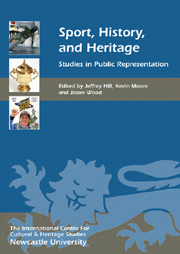Book contents
- Frontmatter
- Contents
- List of Illustrations
- Acknowledgments
- Sport, History and Heritage: An Investigation into the Public Representation of Sport – Editors' General Introduction
- HISTORY, HERITAGE AND SPORT
- MUSEUMS AND THE REPRESENTATION OF SPORT
- SURVIVALS AND LEGACIES: SPORT, HERITAGE AND IDENTITY
- 12 Survivals and Legacies: Sport, Heritage and Identity
- 13 Anfield: Relocating Liverpool's Spiritual Home
- 14 The Canonisation of Common People: Memorialisation and Commemoration in Football
- 15 Heritage, Culture and Identity: The Case of Gaelic Games
- 16 Olympic Heritage – An International Legacy: The Invention of the Modern Olympic Stadium from Coubertin to 1948
- 17 The Indianapolis 500: Making the Pilgrimage to the ‘Yard of Bricks’
- Afterword: History and Heritage in Sport
- List of Contributors
- Index
- HERITAGE MATTERS
16 - Olympic Heritage – An International Legacy: The Invention of the Modern Olympic Stadium from Coubertin to 1948
from SURVIVALS AND LEGACIES: SPORT, HERITAGE AND IDENTITY
Published online by Cambridge University Press: 05 April 2013
- Frontmatter
- Contents
- List of Illustrations
- Acknowledgments
- Sport, History and Heritage: An Investigation into the Public Representation of Sport – Editors' General Introduction
- HISTORY, HERITAGE AND SPORT
- MUSEUMS AND THE REPRESENTATION OF SPORT
- SURVIVALS AND LEGACIES: SPORT, HERITAGE AND IDENTITY
- 12 Survivals and Legacies: Sport, Heritage and Identity
- 13 Anfield: Relocating Liverpool's Spiritual Home
- 14 The Canonisation of Common People: Memorialisation and Commemoration in Football
- 15 Heritage, Culture and Identity: The Case of Gaelic Games
- 16 Olympic Heritage – An International Legacy: The Invention of the Modern Olympic Stadium from Coubertin to 1948
- 17 The Indianapolis 500: Making the Pilgrimage to the ‘Yard of Bricks’
- Afterword: History and Heritage in Sport
- List of Contributors
- Index
- HERITAGE MATTERS
Summary
From their revival at the end of the 19th century at the instigation of Pierre de Coubertin, the modern Olympics have progressively developed to meet the needs of various sports and the expectations of spectators. However, what has changed little is the central position of the Olympic stadium. Throughout the 20th century, stadiums have become landmarks in Olympic history and a focus for national pride and representation. Their design and development reflects improvements in sporting achievements and in technical competence. And they set a clear legacy which has a double dimension: on the one hand, stadiums supply a material legacy in terms of infrastructure; on the other hand, they create an image for both the Olympic movement and the hosting city.
The aim of this chapter is to examine the concept of the Olympic stadium in the first half of the 20th century (see Wimmer 1976; Schmidt 1986a; 1986b; 1988) and in particular to see how successive Games built on previous experiences of stadium design as part of a perpetual and always evolving legacy. The use of the word ‘legacy’ has become fashionable in the Olympic movement's discourses: adoption of the term ‘Olympic legacy’ makes clear the shift from being a ‘peace movement’ to a ‘brand’ (MacAloon 2008, 2061). For academic purposes, ‘legacy’ embraces the effects of all previous Olympic Games in terms of facilities, memory, philosophy and image.
- Type
- Chapter
- Information
- Sport, History, and HeritageStudies in Public Representation, pp. 235 - 246Publisher: Boydell & BrewerPrint publication year: 2012



